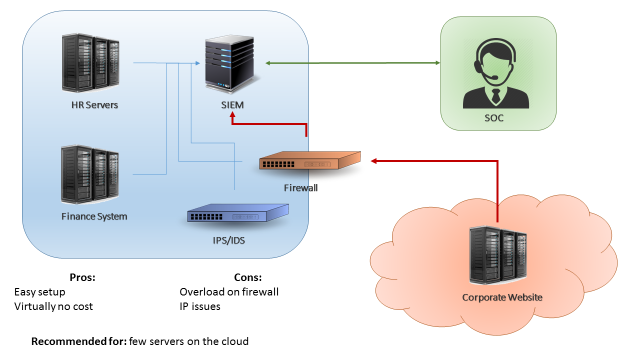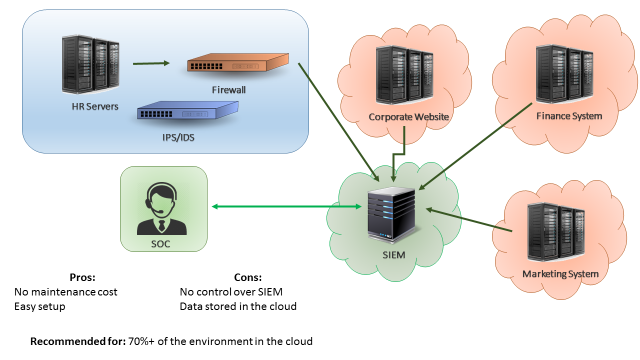Monitoring Cloud Servers with QRadar
Cloud computing is an inevitable upward trend. Companies are looking for all the benefits cloud computing, such as cost effectiveness and scalability, but they may be neglecting the need of event monitoring in a cloud environment.
Configuring a SIEM solution to collect events from servers in a cloud environment may be simpler than you think. Cloud servers are still servers, meaning that they produce logs and events as any in-house server. In this post we will be discussing few strategies and architectures to consider when planning a QRadar implementation with servers in the cloud.
The first scenario is when you have just few servers in the cloud (less than 15% of your environment, or less than 500EPS coming from the cloud). A easy approach for this scenario can be simply configuring your cloud servers to send logs to your existing in-house QRadar collector (Figure 1). This can be accomplished by using a VPN between your cloud environment and your datacentre, or by configuring your firewalls to allow your cloud servers to send logs directly to your in-house collector. The benefits in this case are the fact that is a very easy setup and there’s virtually no costs. The downside on this design is that if your server generate a high number of events, your firewall/VPN could be overloaded.

The second scenario is when you have a substantial amount of servers in the cloud (between 30%-40% of your environment, or less than 5000 EPS). In this case, if you try to send all your events directly through a firewall or VPN you may overload the border network devices of your environment. The recommended approach in this case would be implementing a virtual collector/processor in your cloud environment (Figure 2). The cloud servers would send logs to your virtual collector/processor, which will parse the data locally and compress it before sending to the in-house SIEM collector. This architecture benefits from the fact that you will have an increased EPS capacity. Also, if your VPN dies or if the network is unstable you don’t lose events due to the fact the collector buffers the logs locally. In other hand, this architecture will have an extra cost (the additional collector) and, even with the traffic being compressed, it still may affect your firewall/VPN performance in case you’re monitoring a large quantity of servers.

The third scenario is when most of your servers are in the cloud. In this case, a good approach would be having QRadar collectors (or even your whole QRadar infrastructure) deployed on the cloud, as seen on Figure 3. In this way, your border network devices will not be overloaded by logs sent from cloud servers to your internal SIEM. A similar approach would be having “QRadar as service”, which is a service from IBM where all the SIEM infrastructure is taken care by the IBM team. The advantages of having SIEM as a service is that you don’t need to worry about the SIEM maintenance and there’s little to none setup effort. The disadvantages is that your data will be stored in the IBM cloud environment, which for some companies may not be adequate.

Those are the three most common approaches when monitoring cloud servers with a SIEM solution. It is important to remember that each case is a case, meaning that each company should analyse their current and future environment before designing a SIEM implementation. You may find that a combination of the presented approaches may suit best your needs. The most important thing is remembering that monitoring servers in the cloud is as important as monitoring in-house servers.